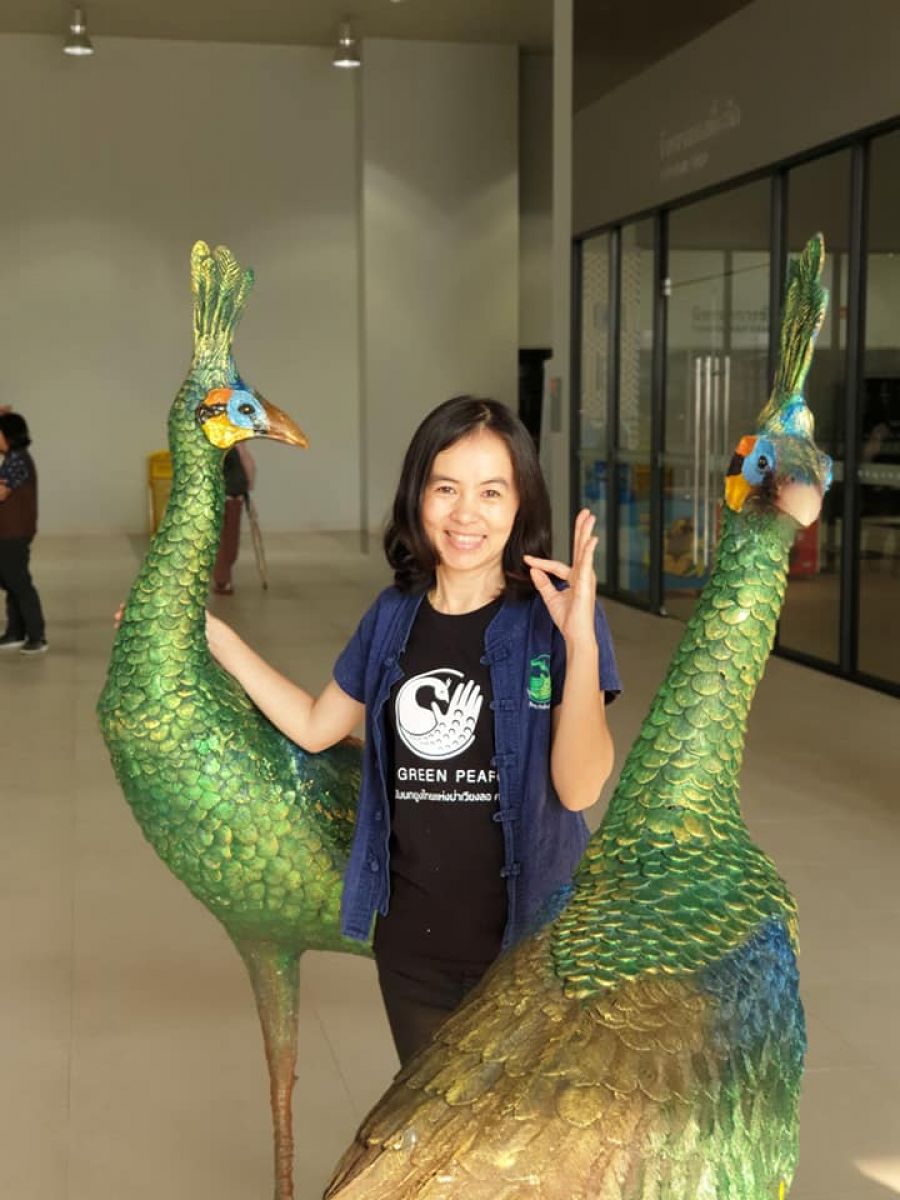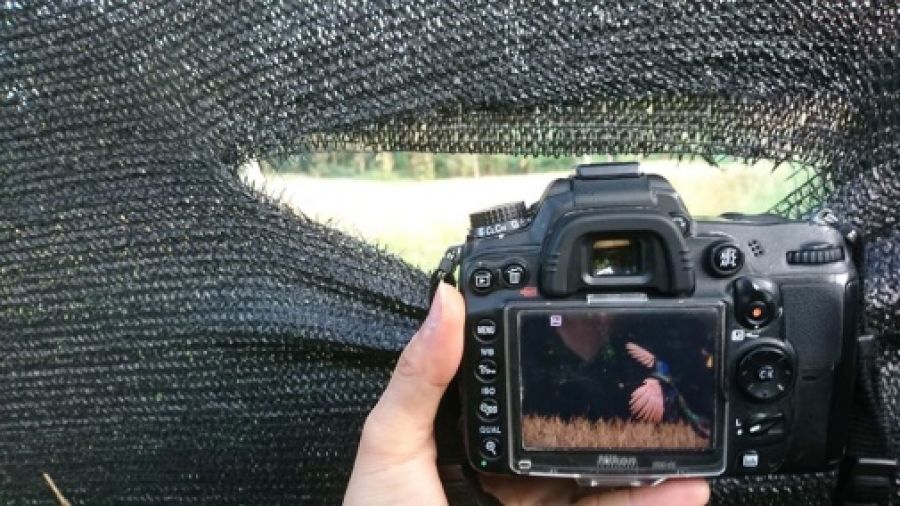If there is a contest for the most beautiful birds in the world one of them probably had the name 'green peafowl ' in the public polls as well, because one of the queens of birds. The ultimate pose is the “spread tail-feather” to find the male's soul mate. In addition to the rhythmic layers of green along the body, the polka dot-like circle pattern is called 'Vaw Mayura' when the peacock spread tail-feather. These are all charms that are not only attracted to females. but also attracts the eyes of the general public.
Howly, apart from the beautiful pictures. On the other hand, is the depressing picture that many people may have seen before. When a forest fire out 1-2 years ago, the picture of green peafowl’s mother was engulfed in flames underneath the stump-black body, there were 4-5 eggs, the maternal instinct that, even after her death to protects her eggs until the last moment. According to the stories of forest officials at Wiang Lo Wildlife Sanctuary. It wasn't the only nest that had to suffer such a fate.
Even the stories about Thai green peafowl that people know are only black and white. but in fact The existence of natural green peafowl in Thailand is a gray matter. That is between the words 'conservation' and 'development' many years ago. Green peafowl are relegated like wild elephants that encroach on the crops of villagers. even though it is a protected wildlife. Fortunately, there are still a group of people trying to turn the crisis into an opportunity for 'people and green peafowl can live together with happily'.
Last stronghold “green peafowl”
Chiang Rai Phayao Phrae Nan is one of 4 provinces that rely on Thai peacocks or green peafowl. In the largest reserve in the country. The IUCN is listed on the Endangered Species Red-List, but appears in large areas of the Lanna forest or the northern part of Thailand. Especially the Wiang Lo Wildlife Sanctuary, Jun Subdistrict, Phayao.

Dr. Ruethaipat Pimonsri, Director of Research Plan 'Lanna East Conservation City, a world-class Thai peacock conservation project to tourism, links the creative economy BRI', said one postgraduate student who was interested in peacock issues in 2012, and began to see the importance of green peafowl becoming critical at the time because of the number of green peafowl coming down for food in the villagers' farmland. Damage of 40-50 rai worth nearly 200,000 baht or not less than 20 million baht per year.
Surveys and inquiries by forestry officials in four northern provinces green peafowl were found that not only in the forest area of Chiang Rai, Phayao, Phrae, Nan, but also down to Lampang, Chiang Mai and Lamphun, so only in the four provinces the boundaries in the area were probably more than 300 spots suffered by the villagers.
The crisis has been going on for the past 10 years and has intensified. As a result of the increase in the population of green peafowl. The victims solved the initial problem by dismissing and violent killings. Repeatedly, it also opens up loopholes to the Thai green peafowl trading process. Whether it is eggs or hatching with hens and then selling them as a meat. She said Phayao is thailand's largest source of green peafowl trafficking. This is a threat to the national natural heritage.
How to solve this conflict between people and birds and the wild? This question pops up in her head. The peacock conservation project in forests and community areas was launched the following year and gradually cracked into multidimensional shoots connected to green peafowl conservation.
The above conflict sparked the project owner. Turning the crisis into an opportunity to drive tourism is a tool to connect wild, bird and human together, with the Bird Conservation Society of Thailand. She said all she had to do at this stage was to make a contribution to the community. It is a 'Thai green peafowl Conservation Community Network' that conducts conservation and development activities together between local community leaders. Public, Private and Educational Sectors.
small cogs in the big forest
In addition to the cooperation of the relevant authorities. Intellectuals on university fences have always been part of the project. One of them is two research papers by two young, fourth-year students from the school of science major in biology, University of Phayao.
'thai green peafowl conservation and biological studies in the conservation forest area of University of Phayao is the research of “Akeparp buapratum or ball”. He said it took him three to four months to study the biological behavior at the Wieng lo wildlife sanctuary and doi pu nang, where there are thousands of green peafowl. Compared to the university areas, whether it can be a green peafowl habitat. Phayao is mainly a mixed deciduous forest with deciduous dipterocarp forest, and the university area have the same conditions. Therefore, there is a possibility that green peafowl will be able to live in such areas.
In addition to the villagers suffering, another worrying effect is that it can result in green peafowl behaving violently, such as pecking people, because they use the method of chasing green peafowl with firecrackers, and may use stronger weapons. nesting includes natural enemies such as snakes, dogs and falcons, as well as humans hunting wild animals and collecting forests. to find out what might cause peacocks to become extinct in the future and adjust their behavior so that green peafowl can coexist with humans.
"during the dry season, green peafowls are found at the farmland, and some of them come out to find space for breeding, and the rainy season returns to the forest to lay eggs."
This led to the 'study of green peafowls food in University of Phayao Reserve' by Panakorn Theerathampanya, or 'Nick', to reduce conflict between people and green peafowls by planting their food in the forest to take the green peafowls back into the forest for food. Do not eat agricultural crops of villagers, reducing the encounter as they always have.
"Due to the drought, plants in the forest are scarce, and with a relatively large green peafowl population, it is not enough, so it comes out to feed outside the forest to survive. Follow the fruiting season to preserve those plants, such as planting more along the forest. most of them are grass seeds, but actually green peafowl adapt. They can eat almost any plants."
thai green peafowl on the silk road
To bring Lanna to a 'green peafowl conservation city', they are three key elements. The first is to conserve and take advantage of the natural resource base. the second link green peafowl in social, cultural and belief dimensions. The third is to build brands by using green peafowl as a selling point to create a creative circular economy.
"the concept of this is not just to protect green peafowl, but how to make villagers feel common and engaged in the conservation of green peafowl, becoming a link between forests, nature, villagers and communities that they must live well, thus connecting them with a creative economy that ties in with the cultural dimension, beliefs of green peafowl belonging to ethnic groups." Dr. Ruthaipat tells us about the beginning of the global trade route friendship.
She continued talk that the bond with green peafowl from the past to the present is multidimensional. Green peafowl is a symbol of buddha that leads to auspicious symbols, being a god of myth and faith in many cultures, both spiritual and ethnic tai. Green peafowl are still used as their own symbols and appear concretely in the creation of the identities of twelve panna and teohong. yunnan, self-proclaimed 'Peacock town'

One of the activities that arises from this concept is the Green peafowl counting festival, which takes place from november to march every year called 'Lan Rak Khuang Nokyung', which is like a green peafowl 's nest area, there are 4 spots in 5 communities of Jun district such as khuang 69, khuang kiew kaew, ban xia, khuang khuang, khuang khuang sri muang chum. There are also several community networks that work together to open a homestay welcoming tourists and bird watchers who come to study nature.
"There are two parts of green peafowl that come down to feed in November when rice is out and down to the breeding in the peacock's love season called spread tail-feather, and return to the wild to nest for laying their eggs in march"
There are also green peafowl rice product that make up the nature of the forest, which is abundant upstream forest where green peafowl live. The product is non-toxic rice.
"Green peafowl are very sensitive for insecticides. If they eat rice and do not die, it can be sure that the rice is safe", Moreover in terms of innovations and products, Dr. Ruethaipat said that there are many professors of University of Phayao join with this product, such as the School of Pharmacy together with the School of Dentistry, who have tried to invent herbs in the community to make toothpaste and mouthwash. Not only to conserve Green peafowl but also rising income for people in the community. In other words, we are using green peafowl as a middle for forest conservation in all dimensions, such as extinguish forest fires with, create fire lines or provide funds for firefighters to reduce losses.
therefore, green peafowl connect value with the biodiversity of the area in many areas, including vegetables, fruits, herbs, agricultural produce, wild honey, as well as wisdom heritage, to community products that create a sustainable economy from the biological base.